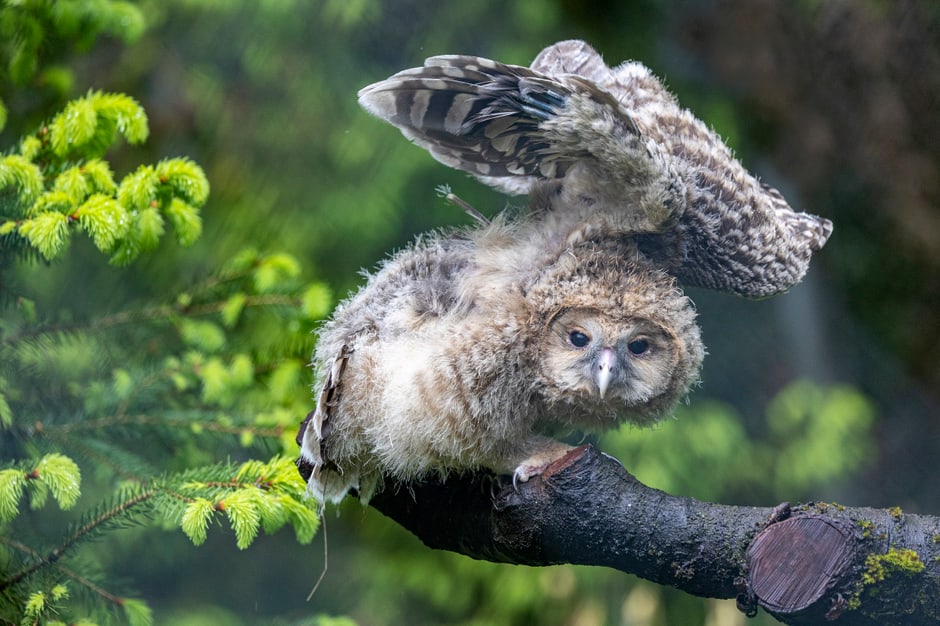From People:
Owls absent from the skies and trees of Austria for decades could be making a comeback.
Three rare Ural owls recently arrived at the Zurich Zoo in Switzerland. The nocturnal birds once plentiful in Austria have been considered extinct in the European country since the mid-20th century, according to Zenger News.
For the past ten years, the Zurich Zoo has been working to reintroduce the Ural owl to Austria. Their three new Ural owl residents are a way for the facility to step up “its commitment to protecting the species” and helping the birds return to one of their native habitats.
According to the Zurich Zoo’s Facebook page, their three Ural owls consist of one male and two females. In a post, the Swiss zoo shared that they are optimistic that the owls will have offspring, which “will hopefully contribute to conservation” of the species.
Ural owls are known for being silent hunters, per Zenger News. The birds can stealthily sneak up on prey without being heard thanks to their velvety, frayed-edge feathers and slow flight.
According to the IUCN Red List, while there are currently no wild Ural owls in Austria, the birds can be found throughout Russia and in numerous European countries, including Finland, Sweden, and Poland. It is estimated that over 350,000 Ural owls are living in the wild.


Translated additional article from the zoo for more background
CLICK THIS LINK! MANY GOOD PICS!
FOUR BEAKS FOR SPECIES CONSERVATION
Since 2009, the Austrian Ornithological Institute and Vetmeduni Vienna have been releasing Ural Owls that have hatched into human care in eastern Austria. The aim is to ensure the long-term survival of the owl species. 2016 was the most successful year of the project so far, with 45 birds released.
Zoo Zurich supports the reintroduction of the Ural Owl by handing over young birds. They strengthen the local population and are an important factor in the conservation effort.
In order for a stable Ural owl population to be established, young birds are needed every year to release them into the wild. Currently, 32 zoos and breeding stations in 7 European countries are participating in the project with 49 breeding pairs.
The releases are carried out in two steps according to a proven method. First, the young owls are placed in an aviary at the release site. This allows them to get used to their new environment.
In July, the birds are then allowed to leave the aviary and look for their own territory. If everything goes as desired, they start courtship in autumn.
Since 2011, the reintroduction project has been observing successful natural broods. 2021 was the most successful breeding year so far with 47 young birds from over 20 pairs detected.
However, counting the Ural Owl is rather difficult. He inhabits a large area. This is often difficult to access and is located high in the mountains. The birds’ mainly nocturnal way of life makes things more difficult. In order to measure the success of the reintroduction, the project is therefore equipping the Ural Owls with transmitters.
Normally, Ural Owls breed in tree hollows or on nests of other large birds. In order to increase breeding success, the “Ural Owl Reintroduction” project is also setting up weather-protected nesting boxes. There are currently 550 of them. Volunteer nest box caretakers check them regularly.
The Ural Owl originally had a continuous distribution from Northern Europe via Russia to Japan. While there are still populations of wild Ural Owls in Eastern Europe today, they have been extinct in our neighboring countries Austria and Germany since the middle of the 20th century. The cause of this was hunting by humans and habitat loss.
It is not entirely clear whether the species was also native to Switzerland. There are historical references, but only a few.
Wow, so in about 6 weeks, they grow from tiny smidgens (video of last year’s brood, listen to the peeps) to ready to fly:
(The video just says that the female laid 4 eggs in March. The male fed her while she sat on them. The chicks hatched over Easter, and if they grow up healthy, they’ll be released in Austria.)
It’s crazy how much they grow in about a month! Good luck little ones!